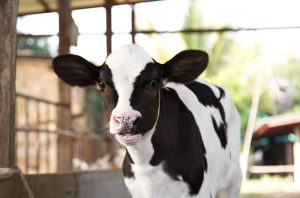By Chris Cassady, Ph.D., Technical Sales Field Manager BioZyme® Inc.
Bull sales are in full swing for spring calving producers, and what an exciting time to find that next source of genetic progress for your herd! Finding the right herd sire is crucial because his genetic influence will represent half of the genetic background in next year’s calf crop.
Purchasing a bull is an investment in your future, and a historical rule of thumb is that a herd bull should be worth about two times the value of a fat steer. However, purebred bull sale averages have skyrocketed in the last 3-4 years. Consequently, it is not only critical to find the best herd sire in your budget to complement your cow base, but nutritional management once he arrives at your operation is paramount in protecting your investment and getting the most out of his sire group.
It’s hard to curb your excitement in purchasing a young bull and flow through the visions of him positively impacting every cow or heifer he covers. Yet we know that not every idea comes to fruition, and there are many production obstacles that must be navigated. It’s important to keep in mind that the desired outcome of pregnancy involves so many factors, yet there are only two possible results: pregnant or open. Considerable attention is placed on the cowherd, whether that is nutritional status (BCS), premium mineral additives, health, and so on. Yet, minimal consideration is placed on the bull. Good management requires success from both the male and female to achieve this financially limiting reproductive result.
Bull buyers vary in available resources and genetics, but bull development strategies from seedstock suppliers, test stations and many others remain constant. In these systems, bulls are developed on a high plane of nutrition for two major reasons: 1. To maximize performance and phenotypic appeal, leading to increased marketing opportunities, and 2. To hasten the onset of sexual maturity. Energy provided to the bull is important during development because low energy diets have resulted in decreased blood FSH and LH levels, critical for bull fertility (Brito et al., 2007).
It’s no secret that in these developmental systems, bulls become adapted to a quality feed without a grazing energy sink, and sometimes over conditioned bulls can be problematic from a reproductive sense. Bulls developed on high concentrate levels have been reported to have decreased libido (Alkass and Bryant, 1984), and reduction in semen quality (Mwansa and Makareechian, 1991) due to increases in scrotal fat deposits and impairment of thermoregulation of the testes. Environmental adaptation extends beyond nutrition, as some bulls may be developed in a much different temperature zone than where they will be servicing females. Therefore, your newly procured herd sire may be biologically shocked once he arrives at your operation if your climate and feed resources are drastically different.
Give yourself ample time to allow this bull to adapt to your region. If possible, allow two months for your new herd sire to adjust to the new environment, facilities and feeding regime. Consider starting with a similar feed to what he was developed with and incorporating higher levels of forages on a weekly basis. Reproductive soundness is very sensitive to energy balance, so make sure to slowly reduce his BCS and transition his daily diet from a high concentrate to forage. Remember, this is a stressful time for the bull and to not cut corners on your mineral. As a matter of fact, Zinc is positively associated with semen quality (Arthington et al., 2002 and Croxford et al., 2011) and organic trace mineral supplementation has proven to improve sperm motility by 7% compared to the inorganic form.
Bottom line – purchasing a new herd bull is exciting, but in order to see your genetic plan come to focus, producers need to pay attention to the changes associated with their previous environment to the new production system. Amaferm® is research proven to promote intake, digestibility and absorption of nutrients, which can help mitigate the negative reproductive effects of a stressful transition.
BioZyme products like the VitaFerm® Concept•Aid® Mineral Tub contain Amaferm as well as highly bioavailable organic trace minerals so you can trust him to get the females he covers in-calf as early in the breeding season as possible. VitaFerm Concept•Aid contains organic copper, zinc and manganese to ensure maximum bioavailability of nutrients to the animal, as well as high levels of vitamin E and selenium to promote optimized fertility.
The investment in premier nutrition is worth it considering increasing bull prices and ensuring your new herd sire has the best chance of helping you reach your production goals through his sire group.



